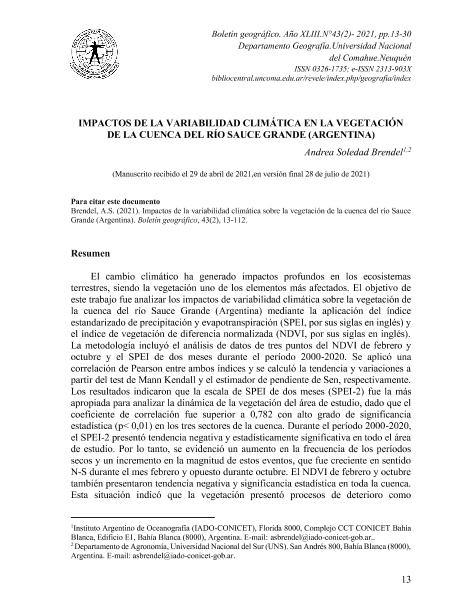Mostrar el registro sencillo del ítem
dc.contributor.author
Brendel, Andrea Soledad

dc.date.available
2022-05-24T11:27:08Z
dc.date.issued
2021-08
dc.identifier.citation
Brendel, Andrea Soledad; Impactos de la variabilidad climática sobre la vegetación de la cuenca del río Sauce Grande (Argentina); Universidad Nacional del Comahue. Facultad de Humanidades. Departamento de Geografía; Boletín geográfico; 43; 2; 8-2021; 13-30
dc.identifier.issn
0326-1735
dc.identifier.uri
http://hdl.handle.net/11336/158109
dc.description.abstract
El cambio climático ha generado impactos profundos en los ecosistemas terrestres, siendo la vegetación uno de los elementos más afectados. El objetivo de este trabajo fue analizar los impactos de variabilidad climática sobre la vegetación de la cuenca del río Sauce Grande (Argentina) mediante la aplicación del índice estandarizado de precipitación y evapotranspiración (SPEI, por sus siglas en inglés) y el índice de vegetación de diferencia normalizada (NDVI, por sus siglas en inglés). La metodología incluyó el análisis de datos de tres puntos del NDVI de febrero y octubre y el SPEI de dos meses durante el período 2000-2020. Se aplicó una correlación de Pearson entre ambos índices y se calculó la tendencia y variaciones a partir del test de Mann Kendall y el estimador de pendiente de Sen, respectivamente. Los resultados indicaron que la escala de SPEI de dos meses (SPEI-2) fue la más apropiada para analizar la dinámica de la vegetación del área de estudio, dado que el coeficiente de correlación fue superior a 0,782 con alto grado de significanciaestadística (p< 0,01) en los tres sectores de la cuenca. Durante el período 2000-2020, el SPEI-2 presentó tendencia negativa y estadísticamente significativa en todo el área de estudio. Por lo tanto, se evidenció un aumento en la frecuencia de los períodos secos y un incremento en la magnitud de estos eventos, que fue creciente en sentido N-S durante el mes febrero y opuesto durante octubre. El NDVI de febrero y octubre también presentaron tendencia negativa y significancia estadística en toda la cuenca. Esta situación indicó que la vegetación presentó procesos de deterioro como consecuencia del incremento de los períodos secos. La cuenca inferior fue la que reflejó los procesos de deterioro más importantes, ya que el NDVI de febrero presentóuna tasa de disminución de -0,032, mientras que el de octubre fue de -0,044 en los 21 años analizados. Los resultados encontrados aportan información fundamental para los tomadores de decisión y los productores agropecuarios, dado que servirá de base para la planificación de las actividades agroeconómicas, para el ordenamiento del territorio y para orientar las políticas públicas destinadas a conservar los recursos naturales de la cuenca del río Sauce Grande.
dc.description.abstract
Climate change has had profound impacts on terrestrial ecosystems, vegetation being one of the most affected elements. The objective of this work was to analyze the impacts of climate variability on the vegetation of the Sauce Grande river basin (Argentina) by applying the standardized precipitation and evapotranspiration index (SPEI) and the vegetation index of normalized difference (NDVI). The methodology included analyzing three-point data from the February and October NDVI and the two-month SPEI during the 2000-2020 period. A Pearson correlation was applied between both indices, and the trend and variations were calculated from the Mann Kendall test and the Sen slope estimator, respectively. The results indicated that the two-month SPEI scale (SPEI-2) was the most appropriate to analyze the dynamics of the vegetation of the study area since the correlation coefficient was higher than 0.782 with a high degree of statistical significance (p <0.01) in the three sectors of the basin. During the 2000-2020 period, the SPEI-2 presented a negative and statistically significant trend throughout the study area. Therefore, there was an increase in the frequency of dry periods and an increase in the magnitude of these events, increasing in the N-S direction during February and the opposite during October. The NDVI for February and October also presented a negative trend and statistical significance throughout the basin. This situation indicated that the vegetation presented deterioration processes as a consequence of the increase in dry periods. The lower basin was the one that reflected the most critical deterioration processes since the February NDVI presented a decrease rate of -0.032, while that of October was -0.044 in the 21 years analyzed. The results were found to provide essential information for decision-makers and agricultural producers since it will serve as a basis for planning agroeconomic activities, land use planning, and guiding public policies to conserve the natural resources of the Sauce Grande river basin.
dc.format
application/pdf
dc.language.iso
spa
dc.publisher
Universidad Nacional del Comahue. Facultad de Humanidades. Departamento de Geografía

dc.rights
info:eu-repo/semantics/openAccess
dc.rights.uri
https://creativecommons.org/licenses/by-nc-sa/2.5/ar/
dc.subject
NDVI
dc.subject
SPEI
dc.subject
TENDENCIA
dc.subject
SEQUÍA
dc.subject
ACTIVIDADES AGROPECUARIAS
dc.subject.classification
Geografía Física

dc.subject.classification
Ciencias de la Tierra y relacionadas con el Medio Ambiente

dc.subject.classification
CIENCIAS NATURALES Y EXACTAS

dc.title
Impactos de la variabilidad climática sobre la vegetación de la cuenca del río Sauce Grande (Argentina)
dc.title
Impacts of climatic variability on the vegetation of the Sauce Grande river basin (Argentina)
dc.type
info:eu-repo/semantics/article
dc.type
info:ar-repo/semantics/artículo
dc.type
info:eu-repo/semantics/publishedVersion
dc.date.updated
2022-04-26T18:47:09Z
dc.identifier.eissn
2313-903X
dc.journal.volume
43
dc.journal.number
2
dc.journal.pagination
13-30
dc.journal.pais
Argentina

dc.journal.ciudad
Neuquén
dc.description.fil
Fil: Brendel, Andrea Soledad. Consejo Nacional de Investigaciones Científicas y Técnicas. Centro Científico Tecnológico Conicet - Bahía Blanca. Instituto Argentino de Oceanografía. Universidad Nacional del Sur. Instituto Argentino de Oceanografía; Argentina. Universidad Nacional del Sur. Departamento de Agronomía; Argentina
dc.journal.title
Boletín geográfico

dc.relation.alternativeid
info:eu-repo/semantics/altIdentifier/url/http://revele.uncoma.edu.ar/htdoc/revele/index.php/geografia/article/view/3256/pdf
dc.relation.alternativeid
info:eu-repo/semantics/altIdentifier/url/http://revele.uncoma.edu.ar/index.php/geografia/article/view/3256
Archivos asociados
